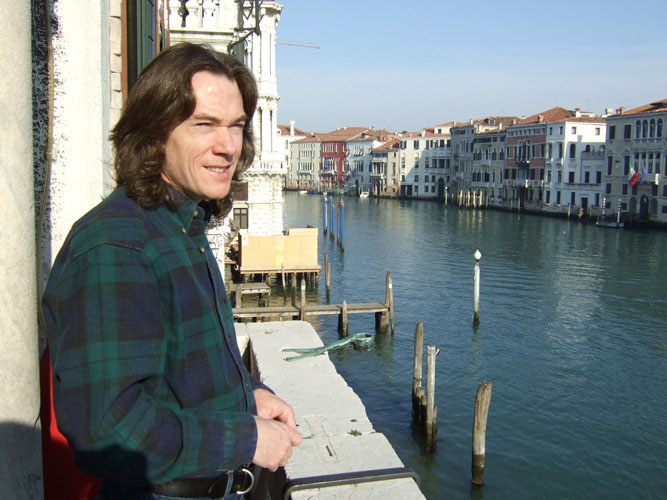 Web UK member Michael Bowdery has recently completed a book in which Marillion feature quite heavily. Entitled Words and Music: Excursions in the Art of Rock Fandom, it is a blend of biography, anecdote, analysis and scholarship and is aimed at all rock fans and music lovers particularly fans of artists such as Deep Purple, Black Sabbath, Led Zeppelin, Bob Dylan, the Doors, Metallica, Iron Maiden, Saxon, Magnum, Geoff Mann, Twelfth Night and Marillion.
Web UK member Michael Bowdery has recently completed a book in which Marillion feature quite heavily. Entitled Words and Music: Excursions in the Art of Rock Fandom, it is a blend of biography, anecdote, analysis and scholarship and is aimed at all rock fans and music lovers particularly fans of artists such as Deep Purple, Black Sabbath, Led Zeppelin, Bob Dylan, the Doors, Metallica, Iron Maiden, Saxon, Magnum, Geoff Mann, Twelfth Night and Marillion.Michael explains, “It describes the ongoing journey of someone who has listened to, and been inspired by, rock music over the last 30 years. The text moves from the excitement of discovery, the joy of sharing and teenage optimism, to a much more introspective, private and personal way of listening to music. Finally matters come full circle with the rediscovery, through music, of much of that early joy. The book contains honest and intelligent reflections on a form of music (in broad terms ‘classic rock’) that so often escapes the attention of thoughtful commentators. It is written from a fan’s perspective with the aim of ‘speaking’ to other fans.”
This will be Michael’s first book though he has, in the past, co-authored research papers and written or contributed to a range of public health information materials and reports. He has worked on the book for two years, whilst also holding down his ‘day-job’, commissioning and managing health and social care research initiatives for the Welsh Assembly Government.
Marillion make many appearances in the book including their own chapter. In the following extract, Michael is having a discussion with his younger sister Fran having just returned from the Marillion Weekend in Holland. It was partly this conversation which pushed him to write the book.
It was early spring 2007. I had recently been to a Marillion Weekend in Port Zelande, Holland. Almost 3,000 Marillion fans from all over the world had descended on a Center Parcs resort on a remote part of the Dutch coast for a four-day celebration of all things Marillion. There was a full line-up of support bands, a pub quiz, a signing session, a Marillion museum, and full and exclusive use of the resort facilities. What’s more, the band themselves stayed on site and played a completely different two and a half hour set each night.
It was a truly international affair. In fact people from 40 different countries were there. I found myself speaking with Americans at Amsterdam airport, lunching with Swedes on arrival, chanting with Spaniards during Saturday night’s covers and rarities set, and waving a flag with a Mexican on Sunday. I renewed my acquaintance with my Greek Cypriot friend Antonis - who I first met in the front row at one of the Astoria gigs on the Marbles tour - and I marvelled at both the enthusiasm and height of the Dutch contingent. In the 1980s, fading rock stars would always claim to be ‘big in Japan’ and have a live album to prove it. Well, Marillion are certainly ‘big in Holland’ – though if success is measured by creativity, artistic integrity, endurance and core-fan loyalty their star can hardly be said to be fading.
I mentioned to Frances that the Center Parcs people in Port Zelande had initially been wary of agreeing to book their entire resort out to 3,000 rock fans. Indeed, there were countless warnings about good behaviour and the resort’s strict ‘zero tolerance’ drugs policy. In the event, everything went so well that the resort management wrote to the band offering two lucky families a free weekend break: “Your fans really are just one big happy family,” the letter had enthused.
“Well, no offence to Marillion,” Frances replied, “but they’re not very ‘rock ‘n’ roll’ these days are they?”
“What do you mean they’re not very rock ‘n’ roll?”
“Well, ‘rock ’n’ roll’ is ‘sex and drugs and rock ’n’ roll’ isn’t it? When you hear ‘3,000 rock fans’ you expect sex and drugs and rowdiness, but it’s not like that with Marillion is it?”
It was a truly international affair. In fact people from 40 different countries were there. I found myself speaking with Americans at Amsterdam airport, lunching with Swedes on arrival, chanting with Spaniards during Saturday night’s covers and rarities set, and waving a flag with a Mexican on Sunday. I renewed my acquaintance with my Greek Cypriot friend Antonis - who I first met in the front row at one of the Astoria gigs on the Marbles tour - and I marvelled at both the enthusiasm and height of the Dutch contingent. In the 1980s, fading rock stars would always claim to be ‘big in Japan’ and have a live album to prove it. Well, Marillion are certainly ‘big in Holland’ – though if success is measured by creativity, artistic integrity, endurance and core-fan loyalty their star can hardly be said to be fading.
I mentioned to Frances that the Center Parcs people in Port Zelande had initially been wary of agreeing to book their entire resort out to 3,000 rock fans. Indeed, there were countless warnings about good behaviour and the resort’s strict ‘zero tolerance’ drugs policy. In the event, everything went so well that the resort management wrote to the band offering two lucky families a free weekend break: “Your fans really are just one big happy family,” the letter had enthused.
“Well, no offence to Marillion,” Frances replied, “but they’re not very ‘rock ‘n’ roll’ these days are they?”
“What do you mean they’re not very rock ‘n’ roll?”
“Well, ‘rock ’n’ roll’ is ‘sex and drugs and rock ’n’ roll’ isn’t it? When you hear ‘3,000 rock fans’ you expect sex and drugs and rowdiness, but it’s not like that with Marillion is it?”
Michael has been a fan since the early days, but drifted away from the band in the late eighties as he no longer related to them as he had done in his younger days. Luckily he rediscovered the band through a friend and also after seeing h’s appearance on HTV discussing how the band had used their fans and the internet to work outside the control of a record company. Here is one of Michael’s earlier experiences of the band as described in his book:
I gathered myself, took a deep breath and approached my hero. His immense presence filled the room, and when he spoke he commanded (if not demanded) the attention of all. It was my turn.
“Can I ask you a question that will probably shatter all my illusions?” I asked. He eyed me cautiously, temporarily disarmed by my approach.
“Er ... yeah, what is it?” he replied, clearly unsure what he was letting himself in for. I held up a fish-shaped earring, the blue and green marble body and silver casing sparkling intermittently as it caught the light.
I gathered myself again, and rather feebly hit him with the ‘big’ question: “Did you used to have the other one of these?”
I was talking to Fish, then-lead singer of progressive rock band Marillion, perhaps the most successful of the bands at the forefront of the prog revival of the early 1980s. I had just been to see them filming at the HTV studios in Bath for a regional youth programme called Side Step. My friend Brendan’s dad worked for HTV and had picked us up a couple of tickets. I had managed to get a couple more from the Marillion fan club – The Web – and offered them to friends Gareth and Mitch who joined us on the 75 minute drive from Cardiff. The band played several tracks for the programme and, once the TV crew had what they wanted, continued playing for half an hour or so for the sake of the audience. There were probably about 50 or 60 of us, all effectively hand-picked from within the fan base, and we were thrilled to a person when Fish announced that despite rumours (or at least, worries) that the band were on the verge of selling out to popular fads and the lure of the singles market, their next album would be a concept album featuring only two tracks – Side 1 and Side 2. It sounded like a throwback to the grand progressive rock ventures of the 1970s and it was exactly what those present wanted to hear. That album turned out to be Misplaced Childhood – the album which allowed Marillion to scale commercial heights hitherto unimaginable for a 1980s progressive rock band. It’s funny how things turn out.
With the band knowing that those present were fan club members, they seemed only too happy to come out after the show to chat and sign autographs. It was the chance I’d been waiting for. The earring had been given to me by an old friend, Siân, who claimed to have followed Fish into a shop on Bangor High Street the day Marillion played Bangor University (in Gwynedd, North Wales) on an early tour. She said she had seen him buying something and, soon after he had left the shop, noticed a box beneath the glass counter with just one earring in it. “Where’s the other one?” she asked the sales assistant (though in Welsh, as Welsh is her first language). “It was bought by the gentleman who was in here a little while ago,” she was told. Of course, realising what a coup this would be, she immediately snapped up the other one for herself. In due course she had sent it to me as a gift. And now here I was, swinging it in front of Fish in a TV studio in the south of England. He took it in his hand, turned it over once or twice and examined it carefully. I was aware of a small crowd forming around us and people pushing in to get a closer look. I was trembling with excitement and anticipation.
“Well,” he said finally, “it looks very much like one that I used to own, but I’ve got loads of them and I tend to lose them on tour.”
“Thanks,” I smiled, and nodded at him – instantly at ease and content. “Can I have your autograph?”
As Fish took my ticket from me and signed the back I felt relief: “Yes!” I congratulated myself, “he said he might have owned the other one.” Quite why I thought this was such a triumph eludes me now...
“Can I ask you a question that will probably shatter all my illusions?” I asked. He eyed me cautiously, temporarily disarmed by my approach.
“Er ... yeah, what is it?” he replied, clearly unsure what he was letting himself in for. I held up a fish-shaped earring, the blue and green marble body and silver casing sparkling intermittently as it caught the light.
I gathered myself again, and rather feebly hit him with the ‘big’ question: “Did you used to have the other one of these?”
I was talking to Fish, then-lead singer of progressive rock band Marillion, perhaps the most successful of the bands at the forefront of the prog revival of the early 1980s. I had just been to see them filming at the HTV studios in Bath for a regional youth programme called Side Step. My friend Brendan’s dad worked for HTV and had picked us up a couple of tickets. I had managed to get a couple more from the Marillion fan club – The Web – and offered them to friends Gareth and Mitch who joined us on the 75 minute drive from Cardiff. The band played several tracks for the programme and, once the TV crew had what they wanted, continued playing for half an hour or so for the sake of the audience. There were probably about 50 or 60 of us, all effectively hand-picked from within the fan base, and we were thrilled to a person when Fish announced that despite rumours (or at least, worries) that the band were on the verge of selling out to popular fads and the lure of the singles market, their next album would be a concept album featuring only two tracks – Side 1 and Side 2. It sounded like a throwback to the grand progressive rock ventures of the 1970s and it was exactly what those present wanted to hear. That album turned out to be Misplaced Childhood – the album which allowed Marillion to scale commercial heights hitherto unimaginable for a 1980s progressive rock band. It’s funny how things turn out.
With the band knowing that those present were fan club members, they seemed only too happy to come out after the show to chat and sign autographs. It was the chance I’d been waiting for. The earring had been given to me by an old friend, Siân, who claimed to have followed Fish into a shop on Bangor High Street the day Marillion played Bangor University (in Gwynedd, North Wales) on an early tour. She said she had seen him buying something and, soon after he had left the shop, noticed a box beneath the glass counter with just one earring in it. “Where’s the other one?” she asked the sales assistant (though in Welsh, as Welsh is her first language). “It was bought by the gentleman who was in here a little while ago,” she was told. Of course, realising what a coup this would be, she immediately snapped up the other one for herself. In due course she had sent it to me as a gift. And now here I was, swinging it in front of Fish in a TV studio in the south of England. He took it in his hand, turned it over once or twice and examined it carefully. I was aware of a small crowd forming around us and people pushing in to get a closer look. I was trembling with excitement and anticipation.
“Well,” he said finally, “it looks very much like one that I used to own, but I’ve got loads of them and I tend to lose them on tour.”
“Thanks,” I smiled, and nodded at him – instantly at ease and content. “Can I have your autograph?”
As Fish took my ticket from me and signed the back I felt relief: “Yes!” I congratulated myself, “he said he might have owned the other one.” Quite why I thought this was such a triumph eludes me now...
Michael is currently working with Steve Williamson of JCS Publishing with a view to making his book available later in the summer. The artwork is being done by Antonio Seijas. He is hoping to set up a dedicated website soon but if you’d like to find out more you can contact Michael through Facebook or at words.music@btinternet.com. We would like to wish him luck with this venture.
First posted on the Web UK website in 2011.
< back


